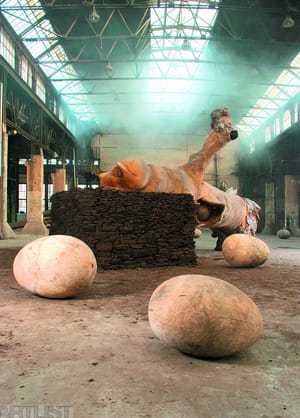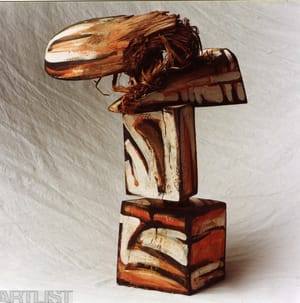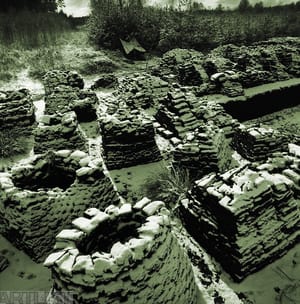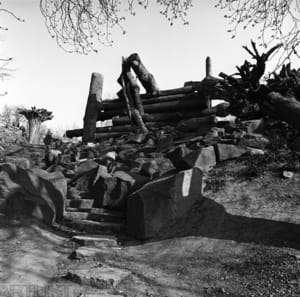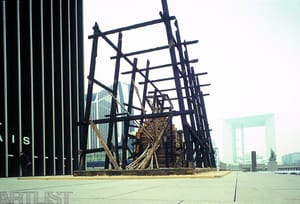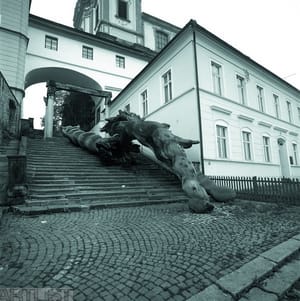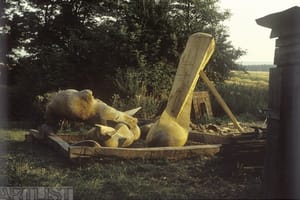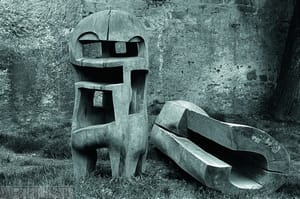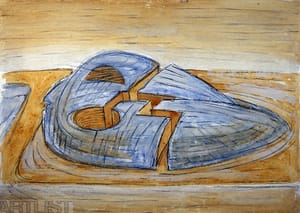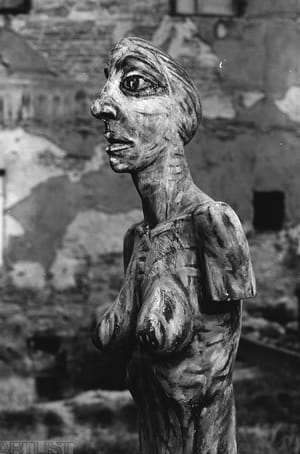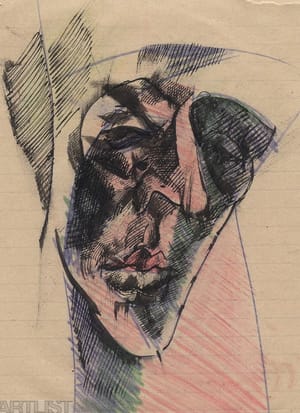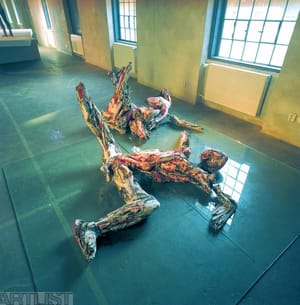- First Name
- Jiří
- Surname
- Beránek
- Born
- 1945
- Birth place
- Borkovice
- Place of work
- Prague
- CSU Library
- ↳ Find in the catalogue
About artist
Jiří Beránek has been working with wood from the beginning of his sculpting career. Shortly after completing his studies in 1972, he started producing figural work. These were distinct expressive figures, finished with polychromy, in which the sculptor refers to famous stories from religious history (Loto’s wife, 1973, Salome, 1973). His figures are intentionally presented in torsos. The break-up of classicist form is compensated by biomorphic shapes, referring to Baroque aesthetics, as well as to some sculpting directions of the 20th century. At the same time, he started to develop non-figural work in which he examines geometric morphology (Cube, 1973). In these works, Beránek examines the inner space of sculpture and spatial relations, and he shifts to abstract expression. At the same time his sense for rustic image of form deepens and is present throughout his entire future work. During the 1970s he creates statues such as The Tower of Babylon (1974), Windy Corner (1974), Shack (1975) or Rock City (1979). Here the author examines his relationship with the memory of a place and he treats the specific determinateness of environment. It is about the idea of an “inhabited sculpture”, which as if had traces of ancient anonymous inhabitants encoded in it. He follows up on this style in the subsequent years, for example with his works Chest (1980), Layers (1982), Corner (1982 and 1984), Resurrection (1990), Place of Sacrifice (1991), Top Floor (1994) and others. Since the 1970s Beránek’s strong relationship to nature – landscape that he perceives also as a place in memory, starts to form. Beránek comes from an agricultural family from southern Bohemia and nature and earth were in his inheritance as something vitally important. This is also were the source of the earthiness of his work and its rustic character comes from. In 1975 it was the artist’s roots that led him to create the earth piece Corridor, and that were the base for the origin of his installations in nature that contain natural materials such as branches, soil or grass (Shack, 1975, Layers, 1986 and 1990, Place Suddenly Abandoned, 1987, Fall to the Ground Floor, 1988, Labyrinth, As if Naked in the Thorns, 1990). One of the climaxes of the tendency, in which Beránek works with earthy materials, was his exhibition Dusk of Memory in the Royal Summer Palace in Prague in 1998. Beránek filled the Summer Palace with an installation of peaty bricks. Beránek’s ancestors used to mine peat for heating in his home village Borkovice. The space of the Summer Place transformed to a sort of sacral place, where Beránek memorialized his ancestors and where sanctity intermeshed with profanity and the archaic with the present. He used a suggestive manner to express the idea of the eternal cycle of vanishing and birth, and he made the eternal elemental energy of the universe current. In Beránek’s depiction “poor” material gains new meaning and changes to mystic matter testifying to the existential presence in our lives. In the 1990s Beránek matures to monumental works, out of which we should mention the broadscale sculpture Resurrection (1990). The artist managed to have this piece of work placed on the extensive La Defénse square in Paris. He created an interesting clash by doing so: he confronted handmade, rustic work with the cold, dehumanized modernistic aesthetics of the perfectionistic, rationalistic skyscrapers.
Through his work Jiří Beránek reveals a world of myths that reach deep into our memory. Through his work he reaches mythologization of nature and its interdigitation with pagan or Christian cults. His style of working also relates to that: Beránek took up country craft traditional working with wood (most likely going back to prehistoric times) and has created work of antonymous quality. With his woodwork Jiří Beránek opened up new horizons in this field already in the 1970s. His spectrum focused on rustic work inspired by primitive art, partly following up on the tradition of Czech woodcarving and partly injecting new impulses into it, drawing from a whole range of modern art. An important factor in Beránek’s work is that it is never just about a mere game with forms, but about accenting spiritual messages.
- Author of the annotation
- Ivona Raimanová
CV
Studies:
1966-1972 Academy of Fine Arts, Prague (V. Makovský a K. Lidický)
1961-1965 The Secondary School of Art, Prague
- Member of art groups included in ARTLIST.
- Member of art groups not included in ARTLIST.
-
1995 S.V.U. Mánes
1987 Volné seskupení 12/15
Exhibitions
- Solo exhibitions
-
2006
Drobná plastika, Galerie Magna, Ostrava
2005
Tři sestry, Galerie U prstenu, Praha
2003
Museum Kampa, Praha
2000
Z kufru, Galerie Gambit, Praha
Nápoj pro tonoucího, Galerie Litera, Praha
1999
Hrad Klenová, Klenová
1998
Přítmí paměti, Letohrádek královny Anny, Praha
Galerie Gema, Praha
1997
Hrad a zámek, Jindřichův Hradec
Plastiky a kresby, Galerie Gema, Dům U dvou divých mužů, Praha
Slepá kolej, Galerie Via Art, Praha
1996
Sochy, Galerie MK, Rožnov pod Radhoštěm
1995
Galerie umění Karlovy Vary, Karlovy Vary
1994
Břevno v oku tvém, Galerie Litera, Praha
Galerie Gema, Praha
1993
Rané obrazy, objekty a sochy, Galerie ´60/´70, Praha
Naklonění, Galerie Via Art, Praha
1992
Kresby a malé plastiky, Galerie Litera, Praha
Kresby, Galerie Gema, Praha
1988
Kresby, Galerie Opatov, Praha
1985
Galerie Opatov, Praha
1983
Realizace ´83, Dvůr (Prostor a kresby), Galerie H náměstí 49, Kostelec nad Černými lesy
1979
Sochy, Divadlo v Nerudovce, Praha
Plastiky, Okresní vlastivědné muzeum, Šumperk
- Group exhibitions not included in ARTLIST.
-
2011
Galerie Litera - rok dvacátý, Galerie Litera, Praha
2008
Moderní a poválečné umění, současné umění, fotografie, Galerie 5. patro, Praha
2007
Od sochy ...: České sochařství 2. poloviny 20. století ze sbírek Galerie Klatovy / Klenová, Galerie U Bílého jednorožce, Klatovy
2006
Doteky země, Galerie moderního umění v Roudnici nad Labem, Roudnice nad Labem
2005
Folklorismy v českém výtvarném umění XX. století, České muzeum výtvarných umění, výstavní prostory, Praha
Velikonoce, Galerie U prstenu, Praha
Exprese / Expressiveness, České muzeum výtvarných umění, výstavní prostory, Praha
2004
Za sklem, Ze sbírky Jaroslava Krbůška, Galerie Jiřího Jílka, Šumperk
Folklorismy v českém výtvarném umění XX. století, Výstavní síň Husova 19-21, Praha
Folklorismy v českém výtvarném umění XX. století, Státní galerie výtvarného umění v Chebu
olklorismy v českém výtvarném umění XX. století, Galerie výtvarného umění v Hodoníně
2002
Divočina - příroda, duše, jazyk, Galerie Klatovy / Klenová, Janovice nad Úhlavou
2000
6 + 1 Jiří Beránek, Václav Bláha, JIří Načeradský, Vladimír Novák, Ivan Ouhel, Jiří Sopko and Pavel Kraus, Czech Centre London (České centrum Londýn), Londýn
Barevná socha, Severočeská galerie výtvarného umění v Litoměřicích
1999
6 + 1 Jiří Beránek, Václav Bláha, JIří Načeradský, Vladimír Novák, Ivan Ouhel, Jiří Sopko and Pavel Kraus, Schick Art Gallery, Skidmore College, New York
1998
...o přírodě..., České muzeum výtvarných umění, výstavní prostory, Praha
1997
Minisalon, Pražský hrad, Praha
Umění zastaveného času / Art when time stood still, Česká výtvarná scéna 1969-1985, Brno
Otevřený dialog / Open Dialogue, Kostel Zvěstování Panny Marie, Litoměřice
1996
Fineart ´96, Valdštejnská jízdárna, Praha
I. nový zlínský salon, Zlín
Slávnosť 25 kunstenaars uit Tsjechische en de Slowaakse Republiek, Venray, Venray
Špét, ábr doch, Niederösterreichischen Landmuseum, Vídeň
Praha Sheffield, City museum and Mappin Art Gallery, Sheffield
Umění zastaveného času / Art when time stood still, Česká výtvarná scéna 1969-1985, Praha
1995
Jiří Beránek, Vladimír Novák: Kresby, Galerie Gema, Praha
Jiří Beránek, Vladimír Novák, Galerie umění Karlovy Vary, Karlovy Vary
1994
Volné seskupení 12/15 Pozdě, ale přece: Menší formáty, Galerie Via Art, Praha
Volné seskupení 12/15 Pozdě, ale přece: U zdymadla, Mánes, Praha
Mánes Mánesu, Mánes, Praha
Jiří Beránek, Vladimír Novák, Karolinum, Křížová chodba, Praha
1993
Staré kresby - nové obrazy - jeden objekt, Středoevropská galerie a nakladatelství, Praha
Trojí dům: Jiří Beránek, Tomáš Švéda, Emauzy, Praha
1992
Česká kresba, Galerie R, Praha
Situace 92, Mánes, Praha
Barok a dnešek, Kostel Zvěstování Panny Marie, Litoměřice
Volné seskupení 12/15 Pozdě, ale přece: Kresby, Art Galerie, Žďár nad Sázavou
Přírůstky českého umění 20. století z let 1989-1992, Jízdárna Pražského hradu, Praha
1991
Šedá cihla 78/1991, Dům umění v Opavě, Opava
Šedá cihla 78/1991, Galerie U Bílého jednorožce, Klatovy
Volné seskupení 12/15 Pozdě, ale přece: Český globus, Městská knihovna, výstavní sály, Praha
1990
Pocta umělců Jindřichovi Chalupeckému, Městská knihovna, Praha
Neoficiální. Umění Československa 1968-1989, Místodržitelský palác, Brno
Volné seskupení 12/15 Pozdě, ale přece: Kreslení, Galerie Fronta, Praha
Nová skupina: Členská výstava, Městská knihovna, Praha
Inoffiziell Kunst der ČSSR 1968 89, Museum der Stadt Regensburg, Regensburg an der Donou
Nová skupina: Členská výstava, Dům umění v Opavě
Czech Art in the Velvet Revolution, Nassau Country Museum of Art, New York
1989
Střední věk, Dům U Kamenného zvonu, Praha
10 Střední věk, Oblastní galerie výtvarného umění ve Zlíně
Középnemzedék / Střední věk, Budapest Galéria Kiállitóháza, Budapešť
1988
První výstava Volného seskupení 12/15 v Kolodějské jízdárně, Jízdárna, Koloděje, Praha
Forum 1988, Holešovická tržnice, Praha
Pět let Galerie H, Galerie H náměstí 49, Kostelec nad Černými lesy
Jeden starší - jeden mladší. Obrazy, sochy, realizace, Lidový dům, Praha
"8" - Jiří Beránek, Kurt Gebauer, Jozef Jankovič, Vladimír Kokolia, Karel Nepraš, Jiří Sobotka, Jiří Sopko, Laco Teren, Brněnské výstaviště, Brno
1987
Dablovky, Galerie H náměstí 49, Kostelec nad Černými lesy
30 výtvarníků v Lidovém domě, Lidový dům, Praha
1985
Jiří Beránek: Sochy: Vladimír Novák: Obrazy, Dům č.p. 39, Kaufferovský, Kostelec nad Černými lesy
Barevná socha, Galerie H náměstí 49, Kostelec nad Černými lesy
1984
Záznam o činnosti, Galerie H náměstí 49, Kostelec nad Černými lesy
Čtyřverší, Galerie H náměstí 49, Kostelec nad Černými lesy
1983
Obrazy a sochy, Obvodní kulturní dům Gong, Praha
Prostor, architektura, výtvarné umění, Výstaviště Černá Louka, Ostrava
Krabičky, Galerie H náměstí 49, Kostelec nad Černými lesy
1982
Setkání na tenisových dvorcích, Tenisové dvorce TJ Sparta Praha, Praha
Jiří Beránek, Václav Bláha, Vladimír Novák, Ivan Ouhel, Petr Pavlík: Obrazy, sochy, kresby, Galerie Fronta, Praha
1980
Člověk, Prostor člověka II., Městské kulturní středisko, Dobříš u Prahy
1978
Konfrontace, Mikrobiologický ústav ČSAV, Praha
1977
Tichá Šárka, Ateliér Magdaleny Jetelové, Praha
